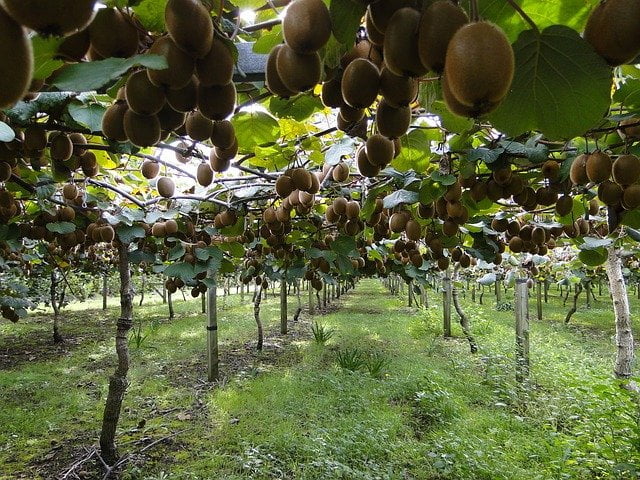कीवी की खेती पर यह मार्गदर्शिका आपको अपने खेत में कीवी की खेती करने में मदद करेगी। विशेषज्ञों द्वारा कीवी खेती के सर्वोत्तम तरीकों के बारे में जानें। कीवी की खेती शुरू करने के लिए एक किसान को सटीक ज्ञान की आवश्यकता होती है।
यदि आप अच्छी कृषि पद्धतियों का पालन करते हैं तो कीवी उगाना लाभदायक है। कीवी फलों की बाजार में भारी मांग है। बाजार मूल्य बढ़ रहा है4.1% वार्षिक की दर से। सूत्रों के अनुसार, वर्ष 2019 में, कीवी का बिक्री मूल्य वैश्विक स्तर पर $6.9 बिलियन को छू गया।
लैवेंडर की खेती की तरह ही, कीवी की खेती छोटे या बड़े खेतों में करने से अच्छी आमदनी हो सकती है।
लेकिन, बिना वैज्ञानिक और शोध के ज्ञान के इन्हें उगाने से नुकसान हो सकता है। इसलिए मैं यह लेख आपके लिए लिख रहा हूं। ताकि आप अच्छी कृषि पद्धतियों का पालन करें और अपने कृषि उद्यम से लाभ अर्जित करें।
Table of Contents
परिचय
कीवी एक पर्णपाती बेल का फल फसल है जो "चीनी करौदा" के नाम से भी लोकप्रिय है। वे विटामिन बी और C के अद्भुत स्रोत हैं। इसके अलावा कीवी फल पोटेशियम, फॉस्फोरस, और कैल्शियम जैसे खनिजों से भी भरपूर होते हैं।
लोग कीवी को न केवल फल के रूप में खाते हैं बल्कि इसका उपयोग उद्योगों में शराब और स्क्वैश तैयार करने के लिए भी किया जाता है। इसके अलावा, कीवी की एक परिपक्व बेल से आप 80 से 90 किलोग्राम कीवी फल प्राप्त कर सकते हैं।
तो कल्पना कीजिए कि आप एक एकड़ जमीन से कितना बेच सकते हैं। चाहे आप छोटे पैमाने के किसान हों या बड़े पैमाने के किसान, कीवी की खेती करने से मुनाफा कमाने में मदद मिल सकती है।
वानस्पतिक वर्गीकरण
वानस्पतिक नाम: एक्टिनिडिया डेलिसिओसा या ए. चिनेंसिस
परिवार: एक्टिनिडिएसी
गण: एरिकलेस
क्लास: माग्नोलियोप्सिडा
डिवीजन: मैग्नोलियोफाइटा
गुणसूत्र संख्या: 29
स्रोत: www.ncbi.nlm.nih.gov
कीवी फल की उत्पत्ति
zespri.com के अनुसार, कीवी फल की उत्पत्ति चीन में हुई है। "यांग ताओ" चीन में कीवीफ्रूट का लोकप्रिय नाम था। हालांकि, 20th सदी के दौरान, इसाबेल फ्रेजर, एक स्कूल प्रिंसिपल चीन से न्यूजीलैंड में कीवी के बीज लाए।
न्यूजीलैंड में कीवी किस्मों की खेती और विकास बड़े पैमाने पर शुरू हुआ।
क्षेत्र और उत्पादन
atlasbig.com के अनुसार, वर्ष 2018 में विश्व स्तर पर 4 मिलियन टन कीवी का उत्पादन किया गया था। हालांकि, चीन अग्रणी उत्पादक कीवी का, यह लगभग 2.2 मिलियन टन का उत्पादन करता है। चीन दुनिया के कुल कीवी उत्पादन के आधे से थोड़ा अधिक उत्पादन करता है।
इसके बाद इटली, न्यूजीलैंड, ईरान, चिली, ग्रीस, फ्रांस, तुर्की आदि का स्थान है।
कीवी खेती गाइड
कीवी की सफल खेती के लिए आपको कीवी की खेती की सर्वोत्तम वैज्ञानिक विधि जानने की आवश्यकता है। इसके अलावा, कीवी लताओं को उगाने के लिए मिट्टी और जलवायु की आवश्यकताओं के बारे में जानें।
मिट्टी की आवश्यकता
कीवी की खेती के लिए, गहरी, समृद्ध, और अच्छी जल निकासी रेतीली दोमट मिट्टी आदर्श है। हालांकि, मिट्टी का पीएच 6.5 से 7.3 के बीच होना चाहिए। मिट्टी का पीएच 7.3 से अधिक होने से उपज कम हो सकती है।
ऐसा इसलिए है क्योंकि 7.3 से अधिक pH वाली मिट्टी में मैग्नीशियम की कमी पाई जाती है।
जलवायु और तापमान
कीवी फल की बेल ठंडा मौसम की फसल है। इसलिए यह गर्म जलवायु को सहन नहीं कर सकता है। आप कीवी को यूएसडीए प्लांट हार्डनेस जोन 5, 6, 7, 8, और 9 में उगा सकते हैं। कीवी का पौधा पाला नहीं झेल सकता लेकिन 800 ठंड के घंटे की आवश्यकता होती है।
इसका मतलब है कि सर्दियों के दौरान कम से कम 700 से 800 घंटे तक औसत तापमान 7 डिग्री सेल्सियस से नीचे रहना चाहिए। पहाड़ी क्षेत्र जो समुद्र तल से 800 से 1500 मीटर ऊपर हैं, उन्हें कीवी की खेती के लिए आदर्श माना जाता है।
गर्मियों के दौरान तापमान 35 डिग्री सेल्सियस से ऊपर नहीं बढ़ना चाहिए। इस तापमान सीमा से ऊपर, पत्तियां झुलस सकती हैं।
खेत की तैयारी
आप खड़ी जमीन को छतों में बदलकर कीवी खेती के लिए जमीन तैयार कर सकते हैं। पंक्तियों की दिशा उत्तर दक्षिण दिशा में होनी चाहिए। यह लताओं की वृद्धि के लिए आवश्यक अधिकतम सूर्य के प्रकाश का उपयोग सुनिश्चित करेगा।
दिसम्बर माह में गड्ढे बनाकर जमीन तैयार करें। पंक्ति से पंक्ति के बीच 4 मीटर और पौधे से पौधे तक 5 मीटर से 6 मीटर की दूरी बनाए रखें। दिसंबर के महीने में गड्ढों में फार्म यार्ड खाद या कोई अच्छी तरह से विघटित जैविक खाद डालें।
गड्ढे की गहराई उसी गहराई पर होनी चाहिए जिस पर नर्सरी में कीवी बेलें उग रही थीं।
आप खेत में खाद डालने के बाद जीवामृत या संजीवक भी डाल सकते हैं। इससे जमीन की उर्वरा शक्ति बढ़ाने में मदद मिलेगी। खेत में जल निकासी का विशेष ध्यान रखें। चूंकि जलभराव की स्थिति कीवी लताओं के विकास को प्रभावित कर सकती है।

रोपण सामग्री और मौसम
You can easily propagate kiwi vine from seeds or vegetative propagation. Propagating kiwi vines from cutting या grafting is considered best for farming practices. This is because they are identical to the mother plant.
And difference between male and female flower bearing plant remains clear. Plant 5 female plants for one male plant. This will help in promoting pollination that will result in higher fruit yield.
The best season for kiwi plantation is during spring season. You can start plantation from late January to March. For plantation adopt T-bar या Pergola system.
At the time of plantation prune kiwi plant to 30 centimetres. This will help in promoting vigorous growth in kiwi plant.
किस्में
Select variety that are suitable for growing in your region. You can contact the nearest Agriculture Department to know about best kiwi varieties. However, Abbott, Allison, Bruno, Hayward, and Monty are the famous varieties of Kiwi.
सिंचाई
Annual rainfall of 150 centimetres/year is sufficient to cultivate kiwi. During summer season, irrigate daily or at a gap of two days. for first five years after plantation. However both excessive irrigation and poor drainage can kill your crop.
But under irrigation can result in reduced or stunted plant growth. You can also use drip, or mini sprinkler, or impact sprinkler for irrigation purpose. This will help in reducing water loss and will result in higher water use efficiency.
Reduce irrigation during September to October. During this time irrigate at an interval of 10 to 15 days. Heavy irrigation during this time can lead to frost damage in plants during winters.
खाद
You can apply fertilizers twice in a year. Give first application during March to April. However, avoid adding fertilizers too close to plant roots. One full bearing vine requires 500 grams of Nitrogen in a year.
Apply 50 to 60% of the total required nitrogen fertilizer during March. And the rest quantity can be applied at once or in two split dozes before August. Along with this you should also apply 600 grams Phosphorus and 800 grams Potassium.
Apply 20 Kilograms of Farm Yard Manure or any bulky organic manure every year as basal doze.

ट्रेनिंग और प्रूनिंग
Training is very important for successful farming of kiwi. Training helps in maintaining a well formed framework of branches. It is necessary to train even before planting of vines or as early after plantation.
You need to erect the growth of supporting vines as well. For this purpose construct three types of supporting structures.
Construct 2 metres high pillars made up of wood, concrete or iron. Place them near the growing vines. Fix one 2.5 mm thick tensile wire on the top of the pillars. A cross arm on the pole will carry two outriggered wires.
This training system is known as T bar training system.
Avoid curling of main vines around the pillars. Prune out all lateral branches till the top of the pillar. Pruning top portion of the vine at the end of pillar will help in promoting lateral growth. Hence lateral branches will develop along the wires in the framework.
Winter is the best season for pruning of kiwi vines.
कीट और रोग
No serious pests and diseases affects kiwi crop so far. That’s why it is very profitable to grow. However, excess watering or waterlogging condition can lead to fungal diseases.
Phytopthora a soil fungus can lead to the development of root rot. To avoid any chances of fungal disease avoid over irrigating and maintain good drainage facility. Keep removing any weed time to time.
फसल की कटाई
4 to 5 years after plantation, kiwi vines will start bearing fruits. Due to the variation in temperature and variety the fruit can mature at different times.
Generally they mature earlier in lower altitude and later in higher altitude. Harvest the large sized well developed fruits and leave smaller ones to develop further. From a single vine of kiwi fruit you can harvest around 50 to 100 Kilograms of Kiwi.
सामान्य प्रश्न
Can I do cultivation of kiwi in Bhagalpur?
No, climate of Bhagalpur, Bihar is not suitable for cultivating kiwi. At least 800 chilling hours is required during winters and temperatures during summers should not rise above 35o Celsius.
How many doses to give waste decomposer or micronutrient to kiwi fruit tree?
You can apply waste decomposer once after every 15 days during active growing season of kiwi fruit tree.
Kiwi fruit ripening season in India?
In India, kiwi fruit ripens between October to December.
What is the role of weather in kiwi fruit?
Weather and climate plays crucial role in kiwi fruit. It determines vine development, fruiting, breaking of dormancy, etc.
What are the environmental impacts of transporting kiwi fruit?
Due to evaporation during transportation weight of kiwi fruits get reduced. To prevent this loss, they are wrapped in perforated film and packed in single layers in wooden, or plastic trays with plastic inserts.




Last 5 year I grow kewi plant in my garden but one male or female plant dry
Hi Mohammad Shafi Banday,
Sorry to hear about your loss. But poor health of a plant can be because of various reasons like disease or pest attack, climatic conditions, soil type, etc. However Kiwi plant has specific requirements to grow and fruit properly. Do check out this guide to grow kiwi in your garden – How to grow kiwi.
I hope this will help!
Very nice Informstion.
Please see update in Hindi language.
9650003042
Hi Mahesh Garia,
You can read kiwi farming guide in hindi here – Kiwi Cultivation Hindi
Please provide information regarding kiwi production in view growing in Dist Bageshwar UTTRAKHAND
Hi Mahesh Garia,
You can follow this guide to cultivate kiwi in Bageshwar, Uttarakhand. Hilly regions of Uttarakhand are fit for kiwi farming. If you have any specific query then you can also connect with Agriculture Review on Facebook and Instagram.
I hope this will help!
Can we grow kiwi in west UP
Hi Dharmendra,
Yes you can grow kiwi in hilly regions of Western Uttar Pradesh. Do read soil, climate and temperature requirements for kiwi farming in this guide. It will help you to check whether your farm can fulfil the specific requirements for kiwi cultivation or not. I hope if it matches with the requirements then one day you will be a successful kiwi farmer.
For further help and queries you can connect with me on Facebook and Instagram too. I hope this will help!
Hello Mr.Aditya
That was a really a useful information, can u suggest whether nilgiris district in Tamil Nadu will really suit for kiwi.
Regards,
Prabhakar Mayavelu
Hi Mr. Prabhakar,
Yes, according to the reports of Ministry of Agriculture, you can cultivate kiwi in Nilgiri District in Tamil Nadu.
Can we grow kiwi ph soil 6.0-7.5 karnataka Ap border
Yes, you can cultivate kiwi.